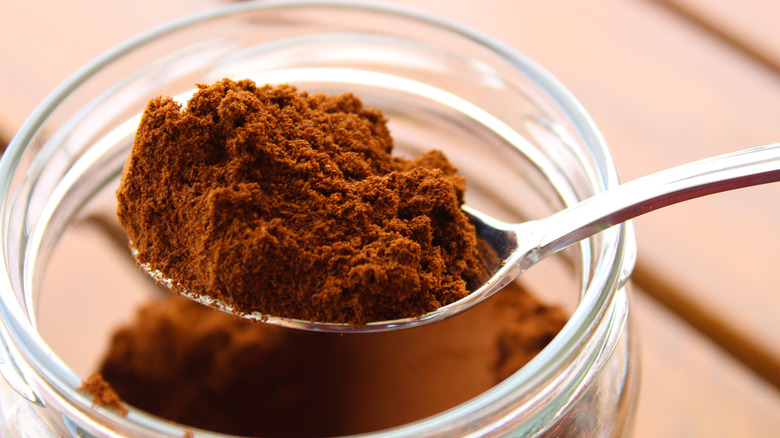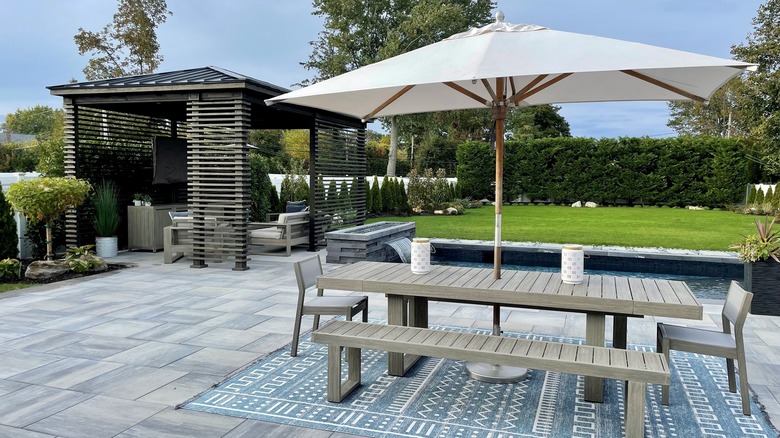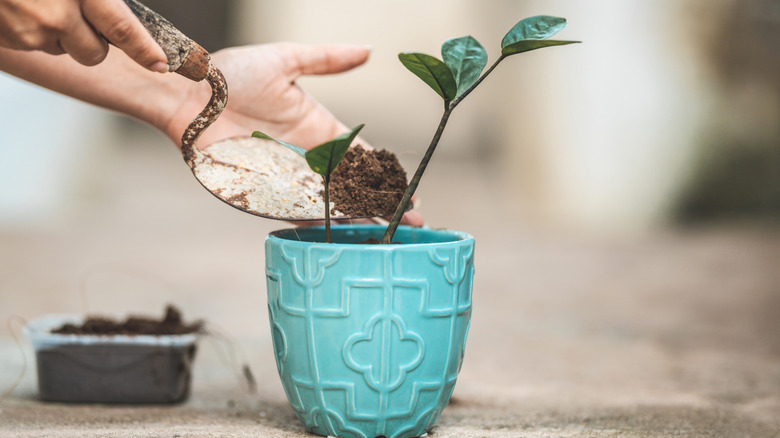Why You Should Look Into Keeping A Jar Of Coffee Grounds On Your Patio
Depending on where you live, mosquitoes can be a major nuisance. Not only do mosquitoes bite, but they also spread diseases and viruses including malaria, dengue virus, and Zika. Controlling the mosquito population around your home's outdoor areas, like the porch or patio, is paramount. Fortunately, everything you need to repel mosquitoes and other pests is probably already a part of your morning routine. Coffee grounds are one of the household staples that repel mosquitos like magic. If you want to keep your home free from mosquitoes during the summer months, consider placing a jar of fresh or used coffee grounds in strategic locations around your patio.
Coffee grounds are especially known for repelling the Aedes albopictus mosquito, which is commonly found in the southeastern United States and in climates that are warm year-round. A study by the National Library of Medicine shows that the scent of coffee grounds repels this mosquito particularly well and even inhibits its ability to reproduce. They're also effective at repelling (and even killing) a number of other pests and improving soil for plants.
How to use coffee grounds to repel mosquitoes
The patio is a great area to place some coffee grounds, particularly if you commonly see mosquitoes in the area. However, coffee grounds are suitable for any outdoor spaces that require some mosquito repellent. Placing coffee grounds on a porch, by the pool, in your garden, or around other seating areas, can be well worth it. You may want to get a few different jars of coffee grounds in a few different areas to keep your home and yard as mosquito-free as possible. You can also make a barrier around your home with coffee grounds by adding them around entry points for a barrier that might discourage pests from accessing your home.
While fresh or used coffee grounds work well for repelling mosquitoes, burning coffee grounds can be even more effective. Simply add some lighter fluid to your coffee grounds or place them in your fire pit. This will create a powerful scented fog that serves as an effective deterrent to mosquitoes.
Other pests you can keep away from your patio or porch with coffee grounds
Although coffee grounds repel the Aedes albopictus mosquito, that's not all they can do. Coffee grounds also help repel ants, wasps, fleas, bees, and many other pests that you see outside your home. Aside from insects, the smell of coffee can also help repel mice and other rodents from your porch or outdoor space. When mixed with water, you can even use coffee grounds to make a soil drench that kills slugs and snails. Placing coffee grounds on your patio or porch serves as an all-in-one solution and gives you a great bang for your buck.
Note that coffee grounds don't kill mosquitoes or most other pests — instead, they work as a repellent that discourages them from coming near your home. Slugs and snails are an exception to this rule. By mixing one-part brewed coffee with two parts water, you make an incredibly effective soil drench that fatally poisons these pests with caffeine.
That said, if you have a significant pest problem on your porch or patio and the coffee grounds aren't as effective as you like, you may want to consider using other methods. For instance, a lethal DIY method like a DIY soapy water trap can help get rid of mosquitoes. As a last resort, consider using pesticides or calling a professional to help with your infestation.
How coffee grounds can help plants on your patio or porch
If you have container plants on your patio or porch, coffee grounds could come in useful in a few ways, too. Used correctly as a soil amendment, they'll improve the quality of the medium. When mixed with the soil, spent coffee grounds eventually decompose and provide a vital source of nutrition for resident microbe populations. In turn, the microbes produce compounds that enhance soil structure. If the plants on your patio need a growing medium with excellent drainage, this type of coffee-ground-induced improvement comes in particularly handy. A ½-inch layer of spent grounds mixed in approximately 4 inches beneath the surface should work well.
You can also add used coffee grounds to your compost bin. When composted, coffee grounds enrich the growing medium with organic material. This material enables the soil to hold more water — a useful quality in the heat of summer, when your potted plants are bound to dry out quickly between waterings. What's more, as organic matter, composted coffee grounds improve plants' resilience to pests and diseases. When adding the grounds to the compost bin, use a ratio of one-part grounds, one-part grass clippings, and three parts leaves. Once the compost is ready, spread it along the soil surface as mulch.
Note that coffee grounds — especially used ones — aren't a miracle solution for your patio or porch plants. Although many gardeners and publications claim that they provide a source of nutrients and even acidify the soil, it's just not so. The brewing process brings their acidity closer to neutral, and the trace amount of nutrients they contain is not enough to make a measurable difference to the plants you're trying to fertilize. Instead, just think of them as an effective (and free!) soil amendment.



